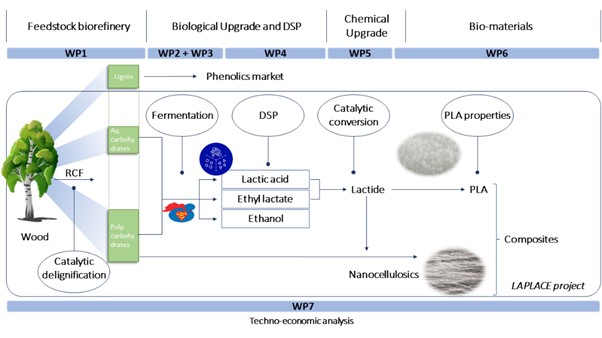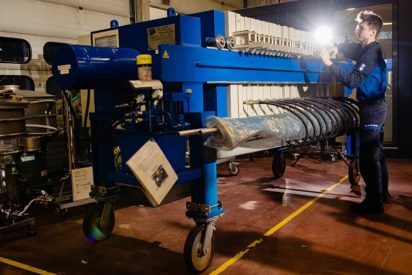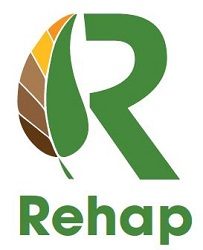Second generation Lactic Acid as a renewable PLAtform for a Circular bioEconomy
Conversion of 2nd generation wood side streams into the industrial platform chemicals lactic acid and lactate esters as building blocks for biobased materials.
Polylactic acid (PLA) is one of the most promising and rapidly growing biobased plastics. Despite it being the most important synthetic bioplastic on the market today, there are many shortcomings associated with the current commercial production of PLA such as cost and waste issues, but also the mechanical properties of standard PLA are sometimes burdensome. Major advantages of PLA are biocompatibility, biodegradability and recyclability. On-purpose synthesis routes towards PLA with versatile and tailor-made properties are thus particularly challenging. The LAPLACE project targets 4 important steps in the value chain towards PLA production with key issues that need to be overcome to advance a new generation of affordable and functional PLA.
- Feedstock: lignocellulose, is considered the most promising, second generation (2G), feedstock for producing lactic acid, due to its availability, low cost, and the fact that it does not compete with food production as sugar/starch feedstocks do. Due to its complex composition (30–60% cellulose, 20–40% hemicellulose and 15–25% lignin), conversion of (hemi)cellulosic materials to lactic acid is more challenging than for 1G sugars.
- Fermentation process and purification: The lack of an organism that efficiently converts all the hexose (glucose, galactose, and mannose) and pentose sugars (xylose and arabinose) to lactic acid in presence of other sugar- and lignin-derived impurities, with minimal waste, is another obstacle to the viable production of the acid.
- Lactide production: commercial PLA synthesis is a multi-step process: lactic acid is first transformed into lactide, which is further polymerized into PLA. The synthesis of the lactide building block is complicated and, with the preceding fermentation, it contributes to 80% of the total production cost.
- Material properties of PLA: Self-reinforced PLA composites, with cellulose nanocrystals as targeted reinforcement at the fusion sections where PLA fibers have to melt and interdiffuse, will give additional advantages to PLA including improved ductility and better mechanical performance, enabling broader substitution of petroleum-based plastics such as PP and PS.

In order to achieve the general objective, we have defined the following specific research objectives that will converge into the general objective:
- Design and insight of a flexible and sustainable RCF refinery process for complex hardwood lignocellulose feed to efficiently produce two carbohydrate-rich fractions (pulp and soluble sugars) and a separate functional lignin (WP1).
- Generation of a non-conventional yeast strain able to fully convert both sugar streams derived from RCF into lactic acid and ethyl lactate (WP2 and WP3).
- Investigation of innovative sustainable separation technologies and design of cost-effective purification strategies to process complex fermentation broths into (multiple) valuable product streams (WP4).
- Catalytic conversion of the resulting biobased mixtures of lactic acid and its esters into lactide as building block for renewable composites (WP5).
- Synthesis of nanocellulose-reinforced PLA composites via self-reinforced processing (WP6).
- Gain insight into the industrial feasibility of the novel production and valorization approaches and benchmark this against current industrial practices (WP7).
ACTIVITIES of the Bio Base Europe Pilot Plant
BBEPP will develop novel downstream separation technologiesfor the efficient recovery of lactic acid, lactate esters and bioethanol, and perform techno-economic assessments of the different production routes.
PARTNERS:
- KU Leuven, BE (Coordinator)
- Bio Base Europe Pilot Plant, BE
SUPPORTED by:
This Project has received funding from the Research Organisation – Flanders (FWO) under file number S004624N.




 webdesign
webdesign